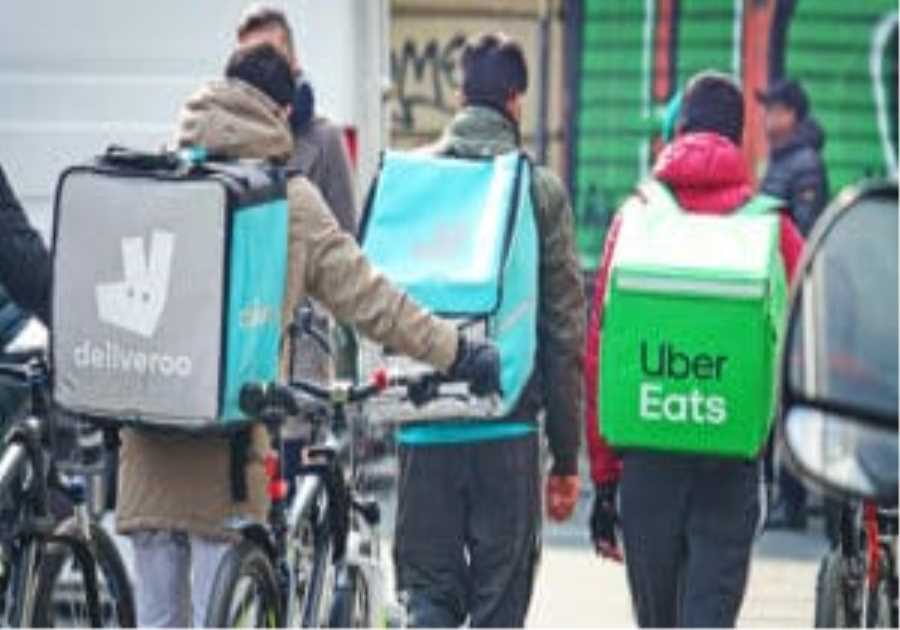Arantza Pena Popo/Insider
In her 20s, Sara Hoy made close friends in her Central Pennsylvania hometown through an organization called Third Place. The group, named after what sociologists call any social setting that's not home (the first place) or work (the second), was led by a local church leader and sought to help young professionals build community.
In her 30s, Hoy joined the Peace Corps in Moldova, and then worked in Korea and Sweden. By the time she came home six years later, most of her Third Place friends had started families, and the sense of community had faded. So when she heard about Culdesac, a buzzy new $170 million car-free community opening up outside Phoenix, she applied to live there, even though she'd never been to Arizona. In May, Hoy became one of the first residents to move in.
Now 40, Hoy lives alone in a studio apartment. She was prepared to feel what millions of Americans feel today: lonely. "I've been through that before living in other places and knowing what I needed to do is put myself out there, introduce myself to neighbors," she said. Culdesac's design, she says, has made that easier.
The development is centered on shared spaces for its 1,000 residents: a plaza, a gym, a grocery store, a restaurant, a coffee shop, coworking space, and shaded courtyards. There's weekly bike karaoke along with art fairs and all sorts of other programming to get neighbors to meet up. Culdesac's founders were inspired by multigenerational Egyptian farming villages, Erin Boyd, the head of government and external affairs, told me. Walkable, tightly knit communities might be new to suburban Arizona, but they're "actually a very old way of living," she said.
Culdesac, in short, is an experiment to save one of the most endangered aspects of American life: a place to hang out.
Third spaces, which include bars, parks, coffee shops, libraries, and even sidewalks, have been in decline for decades. Racism, classism, the climate crisis, overpolicing, a car-based economy, and the privatization and rising costs of amenities have all narrowed access to them.
We're also going to third places less often — working longer hours to compensate for wage stagnation and spending less time with one another. For decades, Americans reported spending about 6 ½ hours a week with friends. But from 2014 to 2019, it suddenly dropped by 37%, to four hours a week. (2014, not coincidentally, was the year smartphone ownership in the US passed 50%.) Instead, we spend much more time online, alone. Instagram, Twitch, and podcasts are the new, placeless third places. We can see this shift everywhere. The characters of the biggest shows of the '90s — "Friends," "Seinfeld," "Cheers" — spent the overwhelming majority of their time hanging out at the café, diner, and bar, and work was either an afterthought or a running joke. In today's biggest shows — "Succession," "Superstore," "Industry" — work is all-consuming, and life beyond it is an afterthought or, in the case of "Severance," wholly inaccessible.
The dwindling of places to spend time together is a catastrophe for our communities and for us, exacerbating what US Surgeon General Vivek Murthy calls an epidemic of loneliness. One in five Americans reported feeling lonely or socially isolated often or all the time in 2018. One study found the rate of loneliness among young adults rose almost every year between 1976 and 2019. In a 2019 YouGov poll, 22% of millennials reported having no friends at all. And being lonely and spending a lot of time alone are associated with bleak health outcomes, including significantly raising the risk of premature death, especially from a stroke or coronary artery disease.
The good news is that more people are seeing loneliness, in part, as a design flaw in the built environment. Researchers, developers, the surgeon general, and elected officials alike are beginning to form a new kind of adage: If you build it, they will come together.
3rd places at a price
How did we get so scattered? Well, cars, for one. As American cities were reshaped around the car in the early 20th century, streets became a lot less welcoming. Cars also brought suburbia, sprawl, highways that slashed through neighborhoods, and an environment that made it easier to isolate yourself in a private vehicle than walk, bike, or take mass transit.
Racial and class segregation have also long shaped and limited access to public places. In New York, the predominantly Black residents of Seneca Village were forcibly displaced to clear the way for the creation of Central Park in the mid-1800s. In Washington, DC, exclusive zoning around Rock Creek Park further separated the city's Black and white residents. In Los Angeles, three Mexican American neighborhoods were destroyed to make way for Dodger Stadium in the 1950s.
Sen. Chris Murphy, a Connecticut Democrat, places some of the blame on the government's decadeslong disinvestment in America's downtowns. "Downtowns were a real place where people connected," he told me. "My sense of identity was very much connected to the localness and to the local identity of the place that I grew up in," which was Wethersfield, Connecticut. Now Murphy thinks both local governments and the federal government should help revitalize downtowns, because "it was government's decision to support unrestrained globalization and online commerce that emptied" them out. The recent rise of remote work has only worsened the problem, further emptying downtowns as businesses abandon offices in droves.
Sen. Tina Smith, a Minnesota Democrat, told me the "privatizing of space" — or when businesses become the only (and cost-prohibitive) third places — also has a lot to do with both rising isolation and income inequality.
"If you look at most major American cities, you see pretty extreme segregation between wealthy communities and poor communities," Smith said. "Wealthy people live in places where they can have big gated houses and their own swimming pool and their own private park." Meanwhile, lower-income and "even middle-class families find themselves living in places where there aren't enough trees, there aren't enough public spaces," she added, "whether it be the local swimming pool or the local park."
When wealthier folks move into lower-income neighborhoods, that gentrification also attracts pricier retail, restaurants, and other amenities that many longtime residents can't afford or don't feel comfortable using. Sweetgreen, Soho House, and SoulCycle are third places only to some. As Leslie Kern, an urban scholar and author, put it, "If your greasy spoon isn't there anymore and now it's a $5 or $6 cup of coffee, instead of a $1 or $2 cup with free refills all day, that's a big barrier." Community-oriented developments like Culdesac, which will offer only market-rate apartments, are also exclusive.
The more things to do, the more people come, the more comfortable people are, the more they interact.
For a time, malls and their food courts served as relatively effective third spaces, says Kern. Though they were privately owned bastions of commercialism, all kinds of people could hang out in them, without needing to spend money. They had heating, air conditioning, and bathrooms. But Hot Topic is no longer a hot topic — as the retail apocalypse continues, malls have been dying in droves.
For the few free-to-affordable third places that remain, says Kern, "there's a lot of pressure" on them "to address, in some way, a lot of challenging social and economic problems." The result: Café workers are fired for feeding homeless people, teens are barred from Chick-fil-A, and older people are limited to 20 minutes at a McDonald's table.
There might be less pressure on private spaces, experts say, if there were attractive and accessible parks, community centers, and other public places.
Building for social connection
"Does the government have a role to play in making sure that every small town has a pub or a local restaurant?" Murphy says. "Maybe not. But we should at least be exploring those questions."
In July, Murphy introduced legislation to form a national strategy to combat loneliness. The bill would create an Office of Social Connection Policy to advise the president and federal agencies on boosting social infrastructure and developing national guidelines for preventing loneliness, and send $5 million a year for the Centers for Disease Control and Prevention to research the prevalence of loneliness.
Murphy also wants to see funds from the 2021 infrastructure bill support more vibrant downtowns and concentrated development, rather than sprawl. And he wants to use tax policy "to help the bottom lines of small retailers, instead of padding the pockets of the big quasi-monopolistic retailers."
Urban planners have also gained a lot of knowledge about the types of places that foster social connection, and the types that don't. "What we call parks look like parking lots with some grass on them, perhaps a baseball diamond. That's not the kind of park that draws people in," Tayana Panova, a researcher who studies the built environment's effects on mental health, told me. "We need parks that have amenities and assets that make it desirable for people to go there." A third space of dreams isn't a barren field. It also includes pools, benches, art, fountains, playgrounds, and food stands — things people gather at. As the climate warms, shade and water are increasingly necessary in outdoor spaces. Culdesac, situated just outside the hottest major city in America, won't have any asphalt and is maximizing shade to cool the neighborhood.
The more things to do, the more people come, the more comfortable people are, the more they interact. Mitchell Reardon, the director of urban planning at the Canadian design firm Happy Cities, pointed to a 2014 study his firm did in Seattle called "the lost-tourist experiment." An actor pretended to be lost on two different street corners, one beside a long blank wall and nothing else, and one next to a bunch of shops and cafés. The "tourist" did their best to look confused and waited for a stranger to volunteer to help them get oriented. On the street with shops, people were four times as likely to stop and offer help than on the street with the wall. One person on the bustling corner even asked the tourist on a date.
"It's really important for people to have space to have a spectrum of participation, to kind of passively observe, actively observe, dip your toes in actually getting involved, and then being fully involved," Reardon said. "The fundamental rule of public space is that what attracts people most is other people."
New York City has fewer than 1,200 public toilets for its 8.5 million residents.
Urban designers have also found that communities need to be part of the process of designing their shared spaces to ensure they're used. Smith told me she recently visited a new community space in Rochester, Minnesota, where a group of immigrant women had been deeply engaged in designing the place. "When they were celebrating Eid, they wanted to celebrate it in one of these public spaces because they had been in on it from the beginning," she said.
Another surefire way to get more Americans to hang out: Legalize public drinking.
As Kristen Ghodsee, an ethnographer who's a professor of Russian and East European Studies at the University of Pennsylvania, noted, public drinking is widespread and celebrated throughout Europe. In Germany, they have a term for the beer you drink as you walk to the next bar, a "wegbier." The US already has regulations around unruly or antisocial behavior that could result from public drinking, Reardon, another proponent of legalized public drinking, said. So it's counterproductive to stop responsible drinkers from enjoying themselves in parks, at street fairs, and in other public places.
People also might go to more places if they had more places to go — public bathrooms. "The key to harmonious living among many people that are not related is lots of toilets," Ghodsee said. "And they knew that in the ninth century," pointing to an architectural drawing from AD 820 of the ideal Benedictine monastery that was full of toilets.
The US, however, has largely neglected this most basic amenity. There are an average of eight public toilets for every 100,000 people in the US, but access to facilities varies widely. New York City has fewer than 1,200 public toilets for its 8.5 million residents. It's a dire situation, and a group of city-council members recently introduced a bill to build another 3,100 toilets in the next 12 years. By contrast, countries like the UK and Switzerland have many more public toilets per capita. Some even double as public art.
People are also willing to pay a premium to live in walkable neighborhoods with lots of third places. Homebuyers in the biggest US cities pay 35% more to live in walkable areas and renters pay 41% more. An overwhelming majority of people say they want to live within an easy walk of amenities like shops and parks and near public transit, a recent survey by the National Association of Realtors found.
Some developers, Culdesac included, are also responding to these demands and building their own 15-minute cities. In Houston, the developer Concept Neighborhood is building a $350 million walkable community with 1,000 homes "around lifestyle-enhancing public infrastructure including transit, trails, bike lanes and parks," according to its website. Another developer is transforming a former strip mall in Austin into a car-light, mixed-use development adjacent to a new light rail.
There are all kinds of ways to combat loneliness, from individual lifestyle changes to national public investments. The surgeon general has called for a multipronged approach, including investing in paid family leave and accessible mass transit; training healthcare providers to address social disconnection among patients; and reforming digital safety rules. The first pillar of his approach, though, is bringing people together through social infrastructure. Fundamentally, society needs places where people aren't alone.
Read More
By: [email protected] (Eliza Relman)
Title: Loneliness is a design flaw
Sourced From: www.businessinsider.com/loneliness-epidemic-decline-in-third-places-friends-parks-community-2023-9
Published Date: Wed, 06 Sep 2023 09:30:01 +0000
.png)





